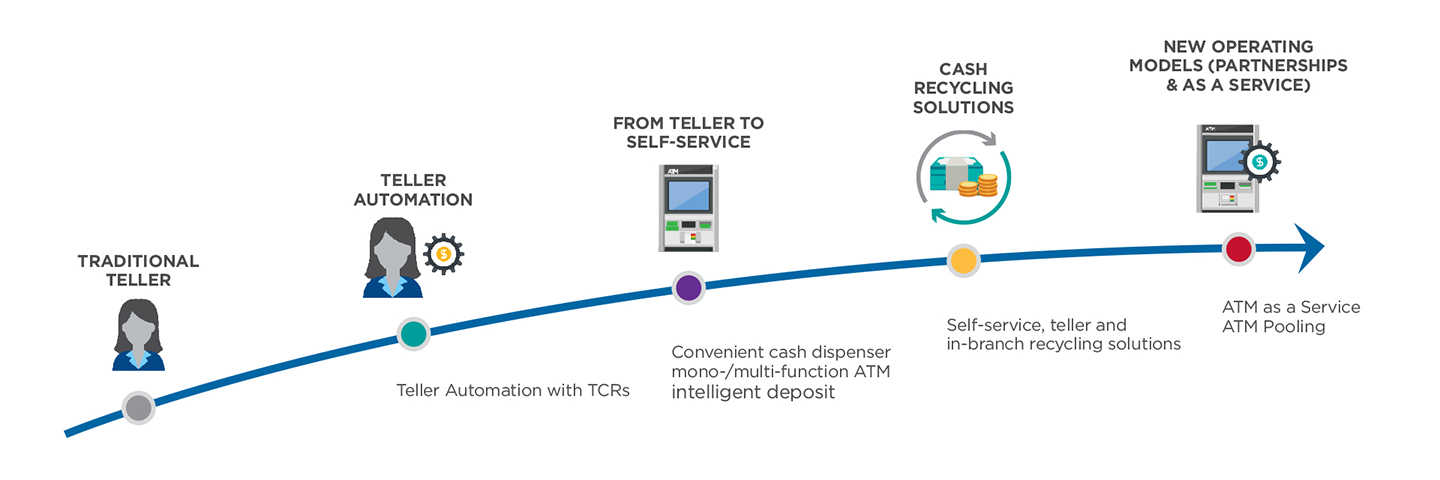While COVID-19 is shaping consumers’ interest in contactless transactions, the desire for cash has not diminished significantly. After an initial decrease of cash usage in the pandemic, we see worldwide that the trend is reversing and that the amount of cash being circulated through the ATM is going up in aggregate. That means cash is a mainstay as a form of payment around the globe.
But cash handling is expensive, and the costs of handling it rise with the volume of cash in circulation. As long as cash is available—whether it’s driven by consumers’ desire to pay however they want, or a response to consumer security and fraud concerns related to paying electronically—FIs need to organize their cash management to keep the cash supply most efficient. In this context, the ATM remains a critical on and off-ramp for cash in circulation, since the self-service channel is the most efficient way to provide easy access to cash to consumers.
Get the most out of the self-service channel with a phased approach to optimization
Implementing self-service options is an important first step in automating processes, but to truly maximize your ROI, the real answer lies in end-to-end optimization of cash processes, something Diebold Nixdorf has helped FIs with for many years.
The first step in the cash automation journey is teller automation with cash recycling at the teller Line. According to the British research and consulting firm RBR, Teller Cash Recyclers (TCRs) now account for almost 86% of all teller assist units and an additional 11,500 TCR units are set to be installed by 2025
1. Teller automation solutions with retail channel integration enable 90% of transactions to be automated without losing the human dimension. Counter formats from teller-operated solutions to consumer-operated solutions with teller assistance are possible.
Without a doubt, though, it’s even more efficient from a cost and availability perspective, to migrate transactions from the teller to self-service. Cash dispensers are very well accepted from a consumer standpoint and automation of withdrawals has reached globally a satisfactory level. And, ATMs enable consumer access 24/7, without the limitation of business hours.
Modern ATMs enable a stronger payment infrastructure in smaller towns and cities, as well as in emerging markets, contributing significantly to financial inclusion.
A critical tool on the cash automation journey is recycling technology
The biggest lever for reducing cash management costs is the automation of cash deposit transactions, which should be a key target in your automation strategy. This can be achieved by introducing cash recycling technology. In a cash recycling scenario, your own consumers are replenishing your ATMs for free. A balance of cash-in and cash-out in a system’s closed cash cycle should lead to perfect cash management. Of course, this requires the migration of cash deposits from the counter to self-service. In fact, cash deposits make up, on average, more than 50% of the cash handling efforts in a branch and personnel expenses make up a majority of these costs.
The ratio of private to small- and medium-business (SMBs) clients has a key impact on recycling efficiency. The ratio of private to business customers usually directly correlates to the ratio of withdrawals to deposits. To benefit from a Cash Recycling System (CRS), a cash balance ratio of 70:30 to 30:70 between the number of dispensed versus deposited notes is optimal.
The migration of business customer deposits from counter to CRS is necessary in most environments to achieve the best balance. And costs for deposits at a recycling self-service system are lower than transactions conducted at the teller line. Our new
DN Series enables FIs to “turn on” recycling with a software update, so your organization has the flexibility to implement recycling where and when it makes the most sense.
Realize more savings when recycling is implemented
Faster and more reliable than any other system available, our cash recycling systems enable providers to offer new and flexible services, reduce the total cost of ownership of their self-service systems, and meet the highest standards of security. The groundbreaking technology platform optimizes cash replenishment and pick-up processes. Combined with innovative software and end-to-end cash management services, the system guarantees audit compliance and maximum transparency of all cash inventories, while transforming the experience of your branch staff and end users.
From there, you may even consider in-branch recycling, which can dramatically reduce CIT visits and drive efficiencies. In this
case study, learn how our client, German bank Volksbank Albstadt, transformed their processes thanks to in-branch recycling.
In this scenario, FIs can swap standardized cassettes between different devices (ATM, TCR, CRS) without the need to open the cassettes in advance.
Whatever your next step is on the cash automation journey, you can rely on Diebold Nixdorf’s future-ready ATMs.
Take a look how industry leaders from around the world are maximizing customer engagement and strategic ROI: download our fintech guide
Self-Service Reloaded.
Helping FIs better understand where and how to optimize their cash processes is our focus. Find out more about how cash recycling could work for your network.
Let’s talk.
1Branch Transformation 2021, RBR
